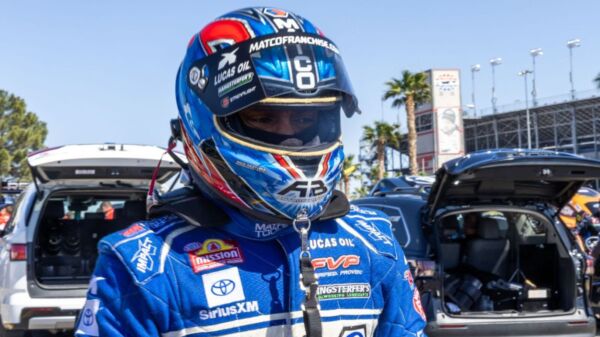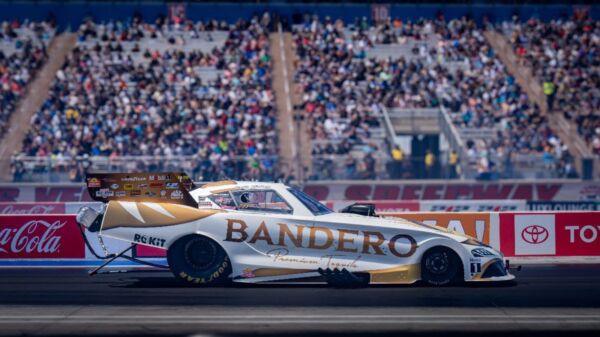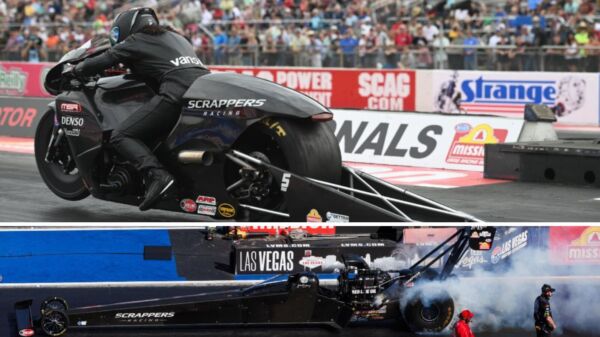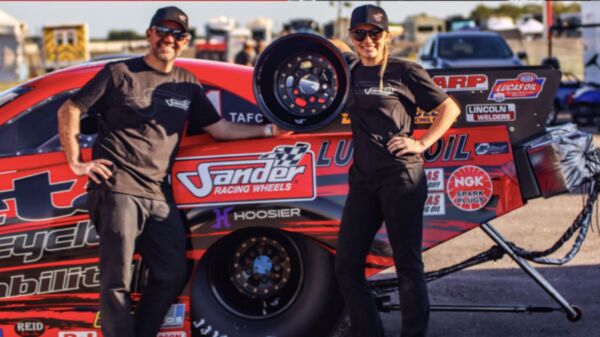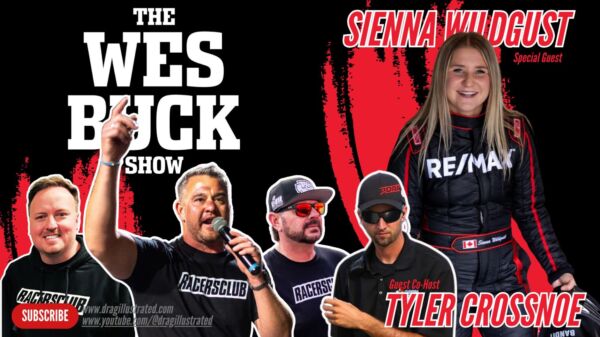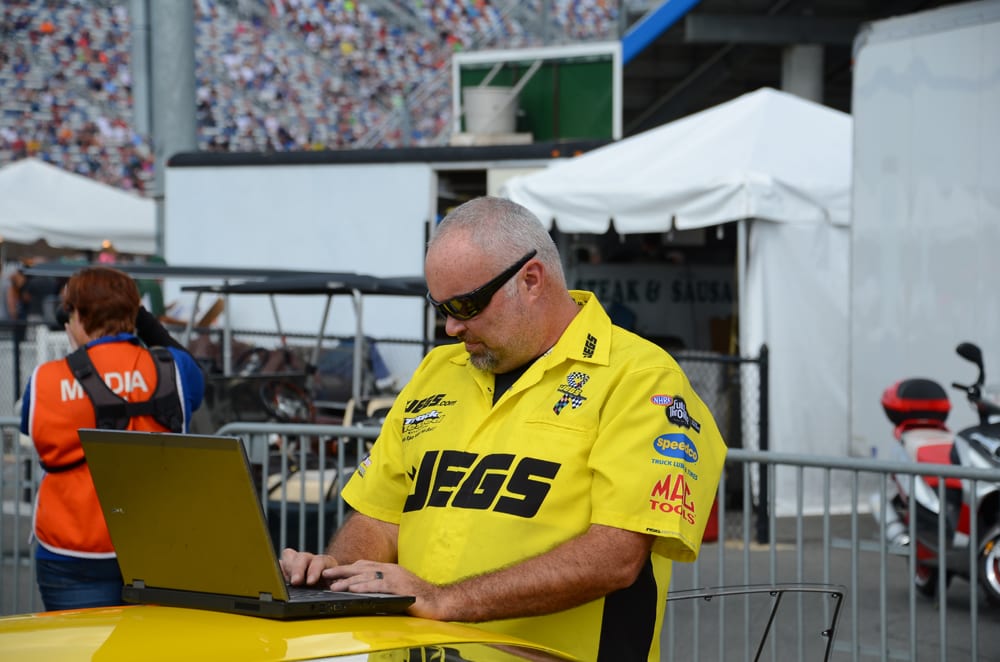No more complicated and controversial class exists in drag racing than Pro Modified, at least when it comes to rules making and enforcement, as the NHRA tech department certainly appreciates. The latest official Pro Mod missive, released by Vice President of Technical Operations Glen Gray, dictated a drop in turbo boost from 38 psi to 36 psi just days ahead of this weekend’s 10th annual Carolina Nationals at Charlotte.
Predictably, the turbocharged contingent of the NHRA J&A Service Pro Mod Drag Racing Series cried foul, while those running supercharged or nitrous-boosted engine combos felt the new limitation didn’t go nearly far enough to contain the turbo’s top-end charge on race day.
The close of Pro Mod qualifying in Charlotte delivered mixed results, as turbocharged Shane Molinari sat atop a list of 23 entries after making a solid 5.77 pass at an also class-best 256.55 mph. The supercharger-driven machine of Mike Castellana was the meat between a turbo sandwich with Sidnei Frigo third, followed by the roots-blown cars of Eric Latino and Mike Janis Sr. before getting to the first nitrous-assisted entry of three-time and defending class champion Rickie Smith in sixth. All told, three of seven turbo entries on the zMax Dragway grounds qualified for the 16-car field, rounded out by turbo standard bearer and two-time class champion Troy Coughlin and crew chief Steve Petty in 12th overall.
That the turbo boost reduction came after Castellana and his Frank Manzo-tuned Camaro qualified number one for the U.S. Nationals with a track record 5.70 at Indianapolis a couple of weeks earlier particularly aggravated Petty.
“Usually I’m pretty quiet and I don’t say much, but this time I’m pissed,” the acknowledged turbo wizard admitted. “When Castellana went 5.70 flat (at 252.52 mph) and we went 5.74 (qualifying second with a track record 258.76 mph), how do they justify a rule change on us? They’re going off what his car did compared to mine in eliminations, but he only lost first round because he had to shut it off when it wheelstood toward the center line. It did not shake, it did not abort because they missed the tune-up; it had the wheels up going to the center line.”
In contrast, Coughlin ran 5.80, 5.75 and 5.77 in eliminations before shutting off early in the final round against Frigo, who earned his career-first NHRA Pro Mod win at the U.S. Nationals. Petty also pointed out he’s seen a copy of the timeslip for Castellana’s aborted first-round effort and the timing numbers to the 330-foot mark indicated another low-5.70 in the making. And in drag racing it really is all about the numbers.
“I’m so frustrated because if those guys can go .70 flat, even when it gets hot and nasty outside there’s no reason why they shouldn’t be going 5.76, 5.77; they should be able to do that,” Petty insisted. “But if you’re a one-trick pony and all you have is a tune-up for the best race track known to man, hey, that’s not our fault. Everybody keeps saying we went faster on Sunday than we went in qualifying, but actually no, we didn’t.
“We went a .75 on Sunday when conditions were very good. But we went a .74 on Saturday in qualifying and in the Friday night qualifier when conditions were so good and Manzo ran his 5.70 flat, we went 5.79, but people don’t realize we pedaled it on that run. It was gonna’ go .71 or .72 when the conditions were right. So we’re really close to Manzo, but when the track gets hot we can slow it down and still get down and I’m frustrated because these guys either have this tune-up or no tune-up because if the track changes, they’re lost. And I feel like we’re paying for that.”
Coughlin said he received a phone call from Gray a couple of days prior to the rule change with an explanation of it coming based on the average performances of the top few cars of each power adder at the previous five Pro Mod events.
“I couldn’t believe it. I even asked him, ‘Really, are you serious?’” Coughlin recalled. “He told me they’re just trying to maintain parity and the turbo cars were running in the mid-.70s and the blower guys weren’t even getting down the track. So I said it’s not our fault if those guys are having trouble getting down the track and I told him that I thought they (NHRA) were making a big mistake.
“With just three races left in our season the timing of this decision is tough, but it’s the NHRA’s sandbox so they can do whatever they want I suppose,” he added in a prepared statement. “The quickest team runs superchargers and they were left as is but turbo cars are being penalized. It seems to me there is no incentive to make more power or try to get better because when you do they just turn around and take it away from you.”
Not too surprisingly, Petty agreed wholeheartedly, saying that’s the most frustrating aspect of this latest development.
“They throw a rule change at us and we go out and develop a new camshaft, cylinder head, whatever it is and we work harder on the car just to get a month or so of it running good just to get hit again,” he said before also complaining about the folly of adding and averaging the performances of the top three or four supercharged cars when Manzo operates in a theater of his own. Meanwhile, he emphasized the top four turbo cars—Coughlin, Frigo, Molinari and Michael Biehle—typically run within four hundredths of one another.
“And you have one engine shop, Proline Racing, that does all the development on all four of those turbo cars and it’s all pretty much shared data,” Petty explained. “You have four crew chiefs, separate entities working on each car, but we still converse with each other and our learning and knowledge base blows everybody else’s away. I mean, we should be running like we do.”
Though their own and Manzo’s tune-ups deliver comparable elapsed times, ironically, Petty and Coughlin said the lack of success by supercharged and nitrous entries other than Castellana and Smith, combined with what they say is NHRA’s methodology for determining the need for rule changes, are what led to them and the rest of the NHRA turbo faithful being penalized.
“There’ve been no rule changes lately for the nitrous cars and they’ve become five or six thousandths slower than they were two or three years ago. Rickie has been 252 mile an hour a couple of times, so he’s capable, and Manzo’s car is fast and it’s capable, but I feel sorry for the rest of those guys because they’re just not keeping up,” Coughlin said. “I think they (NHRA) need to take a look at the fastest cars from each of the three power adders and look at it that way instead of averaging them because especially if you look at the distance between number one and number two in a blower car you’re looking at about a tenth (of a second).”
Coincidentally, that’s the same gap Smith sees existing between his nitrous combo and the twin-turboed version favored by Petty and Coughlin. So while applauding the NHRA for an attempt to narrow the gap with a two-psi turbo boost reduction, Smith feels they’re no more than halfway there.

Rickie Smith
“Hopefully, they’ll take off another two pounds,” the defending class champ said. “And four pounds is not going to slow the turbo guys down to where we could outrun ‘em, but I think it would get them down to where we’d at least have a chance to run within three or four hundredths. Frank (Manzo) probably has four or five hundredths on me, but if NHRA would make just a couple of rule changes to help the nitrous cars I could run within two or three hundredths of him and that would at least give me a chance. But I cannot find eight hundredths to a tenth to catch that turbo car.”
Petty laughed when told of Smith’s comments, pointing out his nitrous rival qualified sixth at Indy with a 5.79, then ran 5.84 and 5.83 in eliminations before falling to Coughlin with another 5.83 in the semis.
On the supercharger side of the equation, veteran crew chief Jimmy Rector, who calls the shots for both Danny Rowe and Steve Matusek, acknowledged Manzo’s dominance and conceded he’s not where he wants to be performance-wise with either of his cars. “If the track was 80 degrees all the time we could get pretty close to them, but they (turbo cars) seem to be able to run 5.70s and it doesn’t much matter if the track is 80 degrees or 140 degrees. It’s just amazing to me,” he said.
Like Smith, though, Rector suspects a two-pound reduction in turbo boost pressure will do little to level the proverbial playing field.
“I don’t really understand the two pounds. I mean, if you take two pounds away from a blower car you’re taking 100 horses, so that’s pretty huge. The turbo guys, when they didn’t have any limit on boost most of ‘em would say they ran 48 pounds and they ran 258, 259 mile an hour. Then they took ‘em down to 43 pounds and they ran 258, 259; then they put ‘em at 41 pounds and they went 258, 259; then they put ‘em at 38 pounds and they went 258, 259; and now they’re at 36 pounds and we’ll see what it does, but I have a feeling I already know how fast they’re gonna’ go. I mean, if you took five pounds away from a blower car we’d run 230 (mph).”

Crew chief Jimmy Rector pulls driver Steve Matusek into the beams at Atlanta Dragway.
According to Petty, beyond turbo boost, several other factors are at work keeping most of the Pro Mod pack at bay. “You have to realize that Rickie is spread between three cars tuning now,” he said. “Do you really think he’s going to run three cars as hard as he is one car? The only year that me and Troy didn’t win a Wally together was the year his son also ran and I was spread between two cars, crew chiefing on both cars. I can tell you that me being spread between two cars drastically affected and hurt our program.”
Coughlin agreed, then added, “let’s not forget, too, that there’ve been no changes for the nitrous cars for the last two or three years and they ran 5.77 at over 250 mile an hour three or four years ago.”
He is referring to Smith’s then-monumental, first-round blast en route to winning the 2014 NHRA Southernationals at Atlanta Dragway. That particular success triggered within 48 hours of Smith hoisting the Wally, an additional 50 pounds being carried by all nitrous entries. So Smith is well familiar with being the target of NHRA’s rules wrath but claimed he understands the need to stay on top of the class in order for everyone to remain competitive.
“When you have three power adders running together you have to be constantly changing the rules, that’s just the way it is. All we can ask for is that NHRA keeps everyone within two or three hundredths so we can go race. That’s all I ask for,” Smith insisted. “I’m not asking to be number-one qualifier—everybody seems to think I want to be on top every round—and I do want to be on top, but at the end of the race. I don’t have to be the quickest car, I just want to be within two or three hundredths so I can still race. If I can’t win some races like that, well that’s my bad luck, that’s on me.”
Petty said he recognizes and respects the effort of competitors like Manzo and Rector and Smith—among others—but budget and more personal matters can’t be overlooked either when determining why some teams excel while others appear perpetually stuck in also-ran status.
“You have to realize that in the blower world, Manzo and Castellana are at the top of the food chain. Everybody calls it Manzo’s car but it’s not, it’s Al Anabi’s car. It’s driven by Mike Castellana, tuned by Frank Manzo, it has two full-time crew members, and it has a full-time chassis guy in Justin Elkes. So they have probably $300,000 to a half-million dollars in salaries alone,” Petty said.
“Now you take some of the (blower) guys that are complaining, they’ve got cars that are several years old, they can’t hire a crew chief so they tune it themselves, and you go through the pits on Saturday night and my two guys are working on the car, servicing everything to make sure it’s one-hundred percent ready for Sunday morning, and you’ve got these other teams that are complaining about the way we run, knee-deep in alcohol, having a good time partying. And I don’t care if you have a good time, but don’t complain then when my guys beat you on Sunday morning.”
For Rector, he’s not complaining, but does express skepticism about NHRA’s capability to even police whatever rule changes it does impose on the turbo combination.
“I really just don’t know that the boost controller really works, is my problem,” he said. “I think they really need to mandate smaller turbos so that they won’t build nuthin’ but 36 or 38 pounds of boost and we don’t have to worry about whether the boost controller is really shutting them off or maybe it ain’t. Now I’m not a turbo guy so I don’t know what that (turbo size) number would be, but I’m sure they could figure it out if they wanted to. I don’t have a problem with the turbo cars at all as long as the tech guys do their job. My point really is if the boost controller is working, they had way, way too much to start with.”
If given the task of maintaining parity in the class, Rector said his efforts would go toward putting all three combinations at approximately the same horsepower level. “Then we can all run 252, 255 (mph) and 5.70s. Then it comes down to a whole package and not based on 500 extra horsepower coming in halfway down the track.”
For Smith, a veteran Pro Stock competitor before turning his attention to Pro Mod shortly after its inception in the early-1990’s, it all comes down to maintaining the integrity and appeal of the class. He said he’d hate to see it all ruined at this point due to complacency about turbo domination that has been building for several years now.
“Look, we’ve been racing nitrous and blower cars since Pro Mod started, thrashing on them more than 20 years, but the turbo cars, they’ve really only been thrashed for what, five years or maybe a little more? But look how far they’ve come in just those five years. So you’ve got to keep after them and stay on top of ‘em because there’s so much power there,” Smith said.
“When they’re making strides like they are, NHRA has got to keep after ‘em in order to keep the class competitive. They can’t let it turn into an all-turbo class. And there’s nothing wrong with running a turbo car, but I don’t want to run one. We all just need to be kept together if we want this thing to remain interesting and keep it to where the fans can enjoy nitrous and blower and turbo cars running against each other.”
Rector and Petty also hold strong opinions on where things went wrong with Pro Mod, at least within NHRA sanction, in the past. For Rector it was in allowing automatic transmissions. “I don’t mind saying this because it’s not anything I haven’t said to them before, but there’s not a turbo car out there with a clutch in it,” he complained. “And it does say ‘pro’ on the door but half of them wouldn’t even qualify if you put a clutch in their cars. That was the biggest mistake NHRA ever let happen was when they let automatic cars in Pro Mod.”
For Petty, it’s too many rule changes to the class as a whole and what he perceives from NHRA as little long-term perception about ramifications to the class or its race teams.
“We’ve been hit with no less than five or six rule changes over the last two years and after the money that Troy has spent and the rest of these guys have spent in order to keep these cars competitive, it makes you start to wonder why you even do it,” Petty said.
“But the real problem now is they should’ve never messed with the rules at the end of last year when the blowers were at 14-and-a-half percent (overdrive). The blowers and the nitrous cars were dead even last year at that point and they should’ve leveled things off there and maybe even made an adjustment to the turbo cars then, if they felt like it was really needed,” Petty unexpectedly suggested. “But instead they blew everything wide open and gave the blowers a crazy advantage to start this year at 20 percent, waited five races in before deciding, whoa, that’s too much, and then backed it off to 16-and-a-half, which is still more than they had last year and still outclasses the nitrous cars. It makes no sense to me.”
Though clearly discouraged and disappointed by what he considers unwarranted punishment, Coughlin said he, Petty and the rest of the JEG’s crew will press on and concentrate on trying to win the final three races this season and possibly wresting a third NHRA Pro Mod championship from current points leader Castellana.
“We’re just going to have to continue working on the whole process from Point A to Point B and we just have to continue figuring out what it takes to win and go do it,” he concluded. “Really, what else can we do?”
This story was originally published on September 17, 2017. 


